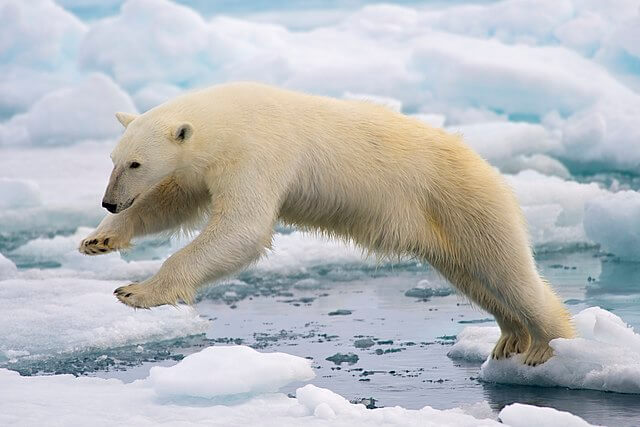
As Arctic sea ice continues to melt due to global warming, some polar bears are facing the threat of starvation, unable to adapt their diets to terrestrial life, scientists have discovered.
Traditionally, these iconic Arctic predators rely on hunting ringed seals on ice floes as their primary source of sustenance. However, with the disappearance of sea ice, many bears are spending more time on land, scavenging for alternative food sources such as bird eggs, berries, and grass.
Unfortunately, these substitutes offer inadequate nutrition, leading to rapid weight loss and heightened mortality risk among the bears.
While polar bears have long served as emblematic symbols of climate change’s impact on the Arctic, the reality of their plight is multifaceted.
Historically, unsustainable hunting drove their population decline until legal protections spurred a recovery in numbers. However, escalating global temperatures now pose an existential threat as the bears’ survival hinges on the frozen Arctic seas.
Sea ice serves as a vital hunting platform for polar bears, particularly during late spring and early summer when ringed seals are abundant. Yet, with increasing ice melt, many regions of the Arctic are experiencing prolonged ice-free periods. In Western Manitoba, for instance, the ice-free season has expanded by three weeks between 1979 and 2015, exacerbating the challenges faced by polar bears.
To comprehend how these animals adapt to dwindling sea ice, researchers conducted a comprehensive three-year study tracking 20 polar bears during the summer months. Equipped with GPS-enabled video camera collars, the bears’ movements, activities, and dietary habits were meticulously monitored.
Despite adopting various survival strategies – from conserving energy to foraging for vegetation or swimming in search of food – the majority of bears experienced significant weight loss, with some shedding up to 11% of their body mass.
On average they lost one kilogramme per day.
“Regardless of which strategy they were trying to use, there was no real benefit to either approach as far as being able to prolong the period that they could survive on land,” according to lead author Dr Anthony Pagano, from the US Geological Survey in Alaska.
“Polar bears are not grizzly bears wearing white coats,” said co-author Charles Robbins from the Washington State University Bear Center.
“They’re very, very different.”
“It really suggests to us that that these bears can’t eat and swim at the same time.”
Notably, one bear exhibited a substantial weight gain of 32kg, attributed to its conservation of energy and fortuitous encounter with an animal carcass.
While previous studies have forecasted long-term challenges posed by climate change, this research underscores immediate concerns regarding polar bears’ adaptability to shifting environments.
Although the study offers critical insights, researchers emphasise that the impacts of climate change may vary by location, highlighting the need for localised conservation efforts.
“It is likely polar bears will disappear from areas where sea ice will be lost in future, but difficult to say just when and where,” said Jon Aars from the Norwegian Polar Institute who was not involved in the study.
“Some areas will have good conditions for bears also many decades from now.”
“The area of this study is one where conditions may be very difficult for bears within a short time, if sea ice continues to disappear as predicted.”
Published in Nature Communications, this study illuminates the urgent need to address climate-driven threats to polar bear populations and underscores the imperative of proactive conservation measures in safeguarding these iconic Arctic species.
——————————————————————————
At Natural World Fund, we are passionate about stopping the decline in our wildlife.
The decline in our wildlife is shocking and frightening. Without much more support, many of the animals we know and love will continue in their decline towards extinction.
When you help to restore a patch of degraded land through rewilding to forests, meadows, or wetlands, you have a massive impact on the biodiversity at a local level. You give animals a home and food that they otherwise would not have had, and it has a positive snowball effect on the food chain.
We are convinced that this is much better for the UK than growing lots of fast-growing coniferous trees, solely to remove carbon, that don’t actually help our animals to thrive.
This is why we stand for restoring nature in the UK through responsible rewilding. For us, it is the right thing to do. Let’s do what’s right for nature!
Donate today at https://naturalworldfund.com/ and join in the solution!

